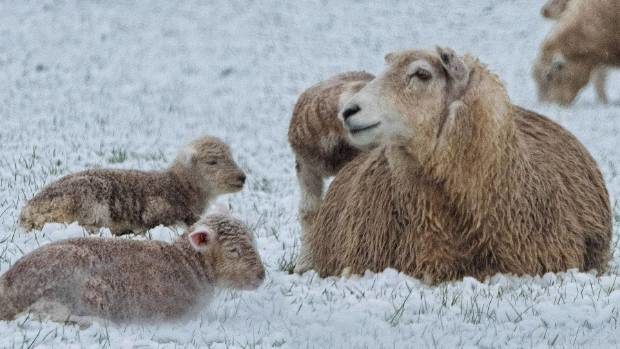
At current prices of $144 per mature lamb, the economic hit could be $14.4 million.
By contrast Otago and Southland farmers are expected to escape lightly from the impact of snow that has fallen on Monday.
Federated Farmers high country chairman Simon Williamson said lambing would not begin in the areas where most snow had fallen until the beginning of October.
"Even though there's a bit of snow on the tops, it's not cold, it's still 5 degrees, and we needed the moisture so it's not too bad," Williamson, who farms near Omarama, said.
AgriHQ analyst Mel Croad described the North Island losses as a devastating blow for farmer morale.
"It's been a cruel start to the spring for many sheep farmers, the first week delivered cold weather and heavy rain which is a pretty tough environment for new born lambs and couldn't come at a worse time for sheep farmers."
She said the losses were a double blow because lamb prices were on a high and were projected to maintain levels through to December.
"It's tough for those farmers who've worked so hard. We've actually come through a relatively smooth sailing through winter up until this first week of spring," Croad said.
Patoka Station, Hawke's Bay owner Ben Crosse said about 750 of his lambs had died, one of the biggest death tolls in his 35 years of farming. He runs 4000 ewes.
He was just at the end of the first lambing cycle so was optimistic his remaining ewes would deliver healthy offspring.
Some sheep farmers he knew had lost 20-30 per cent of their lambs, and dairy farmers had also had their share of calf losses.
Crosse said it was difficult to rescue the lambs, especially if the rain had got to them first. He had managed to put covers over a number, and three-quarters of those had survived.
"But you never know how good your lambing is until the end of the season because anything might happen - we might have an El Nino and a big drought."
"We've had bigger losses before and we will again. It's just bad timing, it's something we can't control," Crosse said.
Wairarapa hill country farmer Jamie Falloon said he had not done a tally of his losses yet, but was expecting a significant number because there had been seven days of cold rain right in the middle of lambing.
"There are a lot of twin ewes who are running about with only one lamb where there should have been two.
"It's all about timing, but that's farming for you, you always have losses and on the hill country you can't get out among the ewes because you just end up mis-mothering more lambs.
"When you try to save them, ewes can walk away from their lambs, or for some reason at two weeks of age the lambs think the quad bike looks and sounds like mum, and they chase after it and lose their mum," Falloon said.
Croad predicted the losses would also have an impact on processors in the New Year because they would have fewer lambs.
A farmer herself in Hawke's Bay, Croad said her losses had been small, but she had heard of other farmers who lost about 20 per cent of their lamb crop.
"Unfortunately the weather pattern just stalled right over us, we received 275 millimetres ourselves and others received more.
Anything born in that period, it was a tough environment for them."
Sometimes farmers were able to rescue lambs but the topography of a farm might mean it was too dangerous to access the sheep.
Beef+Lamb NZ economist Andrew Burtt said it would be devastating for individual farmers, but would not have a huge impact nationally. Each year there are about 19 million lambs and 3.3 million ewes slaughtered.
In the South Island, most of Monday's snow has fallen in the lakes districts of Queenstown and Wanaka, where lambing has only just started.
In fact, Federated Farmers Southland meat and wool chairwoman Bernadette Hunt said the rain that fell in lowland areas was welcome.
"We've had such a mild and dry late winter and spring, we needed the rain."



Comment: See also: Huge late snowfalls in New Zealand build at 10 cm (4 inches) per hour